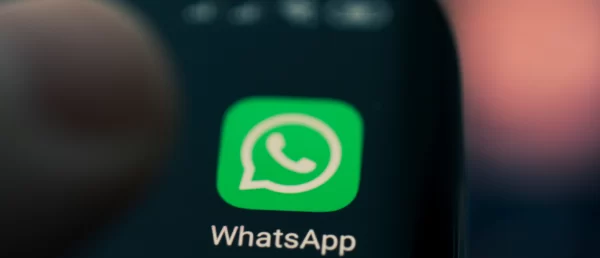
How WhatsApp Works Behind the Scenes
The messaging software industry giant WhatsApp has transformed communication on a worldwide scale. Have you ever wondered about the technology behind those real-time messages and blue ticks? We’ll explore how WhatsApp works in this blog post, revealing the magic that makes it possible for millions of people to communicate easily online.
1. The Foundation: End-to-End Encryption
WhatsApp prides itself on privacy, and at the core of its security architecture is end-to-end encryption. This means that messages are scrambled into unreadable code on the sender’s device and only decoded back to plain text on the recipient’s device. It ensures that only the intended recipient can decipher the message.
2. Real-Time Synchronization: The Role of Servers
When you hit send on a WhatsApp message, the app communicates with a network of servers. These servers play a crucial role in ensuring your message reaches its destination swiftly. They also handle tasks like storing chat history and multimedia content.
3. Message Delivery: The Double Tick System
Ever wondered what those double ticks mean? A single tick indicates that your message has been sent, and the second tick appears when it’s delivered to the recipient’s device. Blue ticks signify that the recipient has read the message, creating a real-time communication experience.
4. Multimedia Magic: Sending Photos, Videos, and Documents
WhatsApp is not just about text messages. You can share photos, videos, documents, and more. Behind the scenes, these multimedia files are compressed for efficient transmission, ensuring a smooth exchange of media-rich content.
5. Voice and Video Calls: Peer-to-Peer Connection
The voice and video call features on WhatsApp rely on a peer-to-peer connection. Once the call is initiated, the data is sent directly between the caller and the recipient, enhancing the speed and quality of the conversation.
6. Group Chats: Managing Multiple Connections
Group chats are a popular feature, and managing multiple connections simultaneously requires robust technology. WhatsApp optimizes group chats to minimize data usage while ensuring real-time updates for all members.
7. Status Updates: Multimedia Storytelling
WhatsApp’s Status feature allows users to share multimedia updates that disappear after 24 hours. Behind this feature is a combination of server storage and end-to-end encryption, creating a secure and ephemeral way to share moments.
8. Continuous Innovations: Regular App Updates
WhatsApp consistently evolves with updates, introducing new features and security enhancements. Regular app updates ensure that users experience improved performance, new functionalities, and strengthened security measures.
Conclusion: Connecting the World, One Message at a Time
WhatsApp’s powerful technology, which underpins every aspect of the app, is equally as important to its success as its user-friendly layout. Real-time synchronization and end-to-end encryption are only two examples of how WhatsApp’s complex mechanism, when comprehended, enables tap-to-global communication.
When you compose your next WhatsApp message, keep in mind the technical symphony that is taking place in the background to enable instantaneous communication across countries.
Feel free to share your thoughts on WhatsApp’s technology or ask any questions about its functionalities!
Frequently Asked Questions (FAQs) related to how WhatsApp works:
Q1: How does end-to-end encryption in WhatsApp work?
A1: End-to-end encryption in WhatsApp ensures that only the sender and the intended recipient can read a message. The message is encrypted on the sender’s device and decrypted on the recipient’s device, preventing unauthorized access during transmission.
Q2: What do the double ticks in WhatsApp signify?
A2: The double ticks in WhatsApp serve as status indicators for message delivery. A single tick indicates that the message has been sent, and the second tick appears when it’s delivered to the recipient’s device. Blue ticks signify that the recipient has read the message.
Q3: How are voice and video calls in WhatsApp secured?
A3: Voice and video calls in WhatsApp use a peer-to-peer connection. This means that the data is sent directly between the caller and the recipient, enhancing the speed and security of the conversation.
Q4: How does WhatsApp handle multimedia files like photos and videos?
A4: WhatsApp compresses multimedia files for efficient transmission. When you share a photo or video, it undergoes compression to ensure smooth exchange without compromising quality.
Q5: What is the technology behind WhatsApp group chats?
A5: WhatsApp optimizes group chats to minimize data usage while ensuring real-time updates for all members. The app efficiently manages multiple connections in group settings.
Q6: How does the Status feature work in WhatsApp?
A6: WhatsApp’s Status feature allows users to share multimedia updates that disappear after 24 hours. It combines server storage and end-to-end encryption, providing a secure and ephemeral way to share moments.
Q7: How frequently does WhatsApp release updates?
A7: WhatsApp regularly releases updates to introduce new features, enhance performance, and strengthen security measures. Users are encouraged to keep their apps up-to-date to benefit from the latest improvements.
Q8: Is WhatsApp’s end-to-end encryption truly secure?
A8: Yes, WhatsApp’s end-to-end encryption is considered highly secure. It ensures that only the sender and recipient can access the content of the messages, providing a robust level of privacy.

Leave a Reply